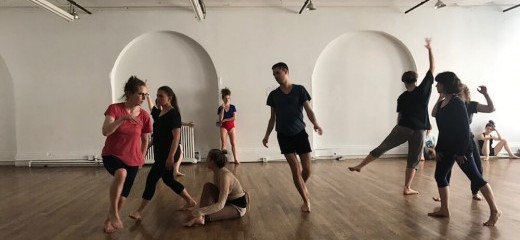
Being a Pig in the Village
by Nicole Bindler
Nicole Bindler has participated in several workshops with Deborah Hay, and in 2011 learned her piece “I Think Not” over 12 days in Findhorn, Scotland, through Hay’s Solo Performance Commissioning Project (SPCP). In 2012 she brought Hay and nine alumni from her SPCP project to Philadelphia for a festival in her honor, the Deborah Hay Solo Festival, which included performances of several of her solos from the 10+ year program at the fidgetspace, a week-long workshop at Mascher Space Cooperative, and a showing of her piece, “A Lecture on the Performance of Beauty,” at University of the Arts. Here, Bindler describes her experience in Hay’s eight-hour workshop, “An Edge is a Field: A Study of the Ensemble in Dance,” through Movement Research.
“An Edge is a Field” is Deborah Hay’s first attempt at teaching dancers how to work with her performance practice material in an ensemble. Throughout her process of developing her ensemble pedagogy, she decided to change the word “ensemble” to “family,” and then to “village.”
How does that language inform our perception of the ensemble? “Village” evokes a relationship to the place, the people, a specific role to play, an organic and changing ecology.
“Don’t do 'the village,'” says Hay, “get moving and call whatever you’re doing ‘the village.’”
Hay says her goal is to “take linear thought and chop it up.” She attempts to explore “the intelligence of the whole body at once as my teacher,” and she says, “You can’t possibly accomplish this task. I want to be clear about this. It’s so absurd. I haven’t gotten it. It’s a practice.”
Hay breaks us up into five groups and names each group: office furniture, paper bag, juicy orange, street car, dead leaf.
“I am teaching myself to be a pig in getting everything I can from my dancing, and the environment in which I dance, and the people with whom I’m dancing.”
She instructs each group to move to the edges and to travel with their group, as a village, across the space in ten minutes, intersecting in the middle as a traffic jam of objects, vehicles, and fruit. I am with the bags.
“Don’t do paper bag. Get moving and call it ‘paper bag.’”
We fold and blow across the room.
“Space can be anything you want it to be.”
I feel myself as an animated bag, and then remember to simply move and call it “paper bag,” which, while absurd, creates opportunities for me to move without any narrative, character, or linear thought. This nonlinearity is in conflict with the task to move in a line across the room, creating a tension that requires so much concentration I forget what my body is doing.
“My movement is not a reflection of what I am doing, but how I am seeing.”
Hay then instructs groups of eight people to cross the space on parallel curves, noticing each other and the audience.
“Be a pig.”
None of the groups can keep track of the spatial pathways. Few people notice the audience or each other.
“Do you know where people are? Notice the audience. You are going to put it off. Don’t fucking put it off.”
She performs a solo for us, demonstrating how to notice the audience without seduction, just a light touch with her eyes.
“Activate your seeing so it’s not separate from your dancing.”
She asks groups of five to practice poetry, collectively, on a zigzag path, as a village. The score gives us the freedom to make choices about the speed and distance of the zig zags, but we are not allowed to go backwards or to travel in any other kind of pathway. This spatial limitation enables us to notice and make choices about our relationship to time.
“Time is in your hands.”
The glow of sunset reflects off the windows across Broadway and pours onto the wood floors of Eden’s Expressway. It is 90 degrees and the space is swollen with humidity, car exhaust, and sirens.
“Be a pig.”
As the conclusion of the day, she instructs us to practice performance in the village during a long score.
“The practice of ‘the village’ is not to do the village, but to learn from the body what the village might be.”
We dance in ensemble throughout dusk, as if a light board were on a 90-minute fade cue.
“Use the sky. Why isn’t the space down here also considered the sky?”
The space around me becomes more viscous.
“I turn my fucking head to challenge my unconscious assumption that I know what I’m doing.”
Hay seems disinterested in what the dancer is doing, and more interested in the how: how to use one’s eyes, attention, and intention to communicate ideas through the body.
“I turn my fucking head to challenge my unconscious assumption that I am doing something.”
Her riddles fill a gap in contemporary dance education, which does not tend to offer the tools of performance presence within technique or composition classes.
“You are being served cellularly.”
I am dancing. I am still. I am turning my fucking head. I am a pig. I eat everything I see. I am thinking about Hay’s personal feedback to me, in which she said I sometimes look bug-eyed. I panic and wonder if there’s something wrong with my thyroid. I practice softening my eyes. It becomes easier as the light diminishes.
“We’ve all been choreographed. How can we approach movement that frees us from our choreography?”
I move in response to what I see, as if my visual sense could be transmuted into a kinesthetic sense. I am a pig.
“What if this studio is serving my moving body?”
I indulge in the pleasure of leaning into other people’s bodies, feeling the weight and pull of their musculature.
“Pleasure can be anywhere. Turn your fucking head. Pleasure can be here and here and here.”
I delight in watching others perform exquisite, idiosyncratic movement, inspired by Hay’s provocations. I allow what I see to inform and motivate the push and reach of my body into the floor and into space. Then I turn my fucking head.
“Notice the feedback and then dis-attach.”
I perceive the walls, objects, and my ensemble-mates proprioceptively, as if I can see with my skin, as if the changing light and the movement of their bodies is penetrating my connective tissue. I am delighted to witness how my body chooses to organize itself in space. My forebrain is the last to know.
An Edge is a Field: A Study of the Ensemble in Dance, Deborah Hay, Movement Research workshop, May 18.
By Nicole Bindler
August 22, 2017

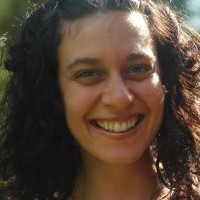
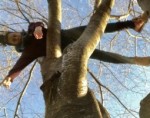
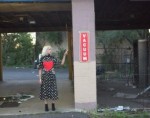
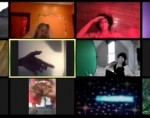

.png)


